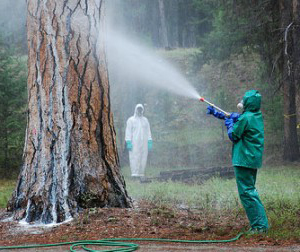
We Spray for Pine Beetles as well as spraying for all kinds of trees and shrubs
Book Now !!!
FAQ
 When do you need to spray for pine beetles?
When do you need to spray for pine beetles?
Spraying typically takes place on an annual basis, from May until mid July.
Which trees need to be sprayed?
The trees being considered should be big enough to be subject to an attack. The trees should be around 6 - 8 inches in diameter, at eye level. The trees to be sprayed should also be signature trees, that is, trees of high-value. The final decision will probably be based how much money a property owner wishes to spend.
What do you use to spray the trees?
We use ASTRO (Permethrin), as well as Sticker, which helps the Permethrin adhere to the trees. This combination provides an extremely powerful and safe formula.
How safe is preventive spraying for the environment?
ASTRO (Permethrin) is relatively environmentally-friendly to animals, birds, and the ground water. Preventive spray dries fairly promptly, after which time normal activity may be resumed.
How much does preventive spraying cost?
Colorado Beetle Busters charges an average of $10 per tree, with special rates for larger jobs.
Where did the infestation in Colorado start?
The Mountain Pine Beetle (MPB) is always present somewhere in Colorado. During low periods of the MPB cycle, called endemics, the MPB would normally be found in stressed trees such as those infested with mistletoe, mechanically damaged by construction or soil compaction, or weather impacted (mainly by drought). There is no epicenter from which the state's infestation started. High periods are called epidemics.
Does cold weather kill the Mountain Pine Beetle and end an epidemic?
It depends. The MPB produces its own anti-freeze type of compound, which protects it from all but the coldest weather. If the below-the-bark temperature reaches 4 degrees below Fahrenheit for a few days straight, the beetles may be killed. To achieve this, the outside-the-bark air temperatures must be below -30 degrees Fahrenheit.
When does the MPB fly?
The normal flight period (the time when the MPBs leave infested trees and fly to attack green trees) in Ponderosa Pine forests is usually mid-July through mid-September. For Lodgepole Pine forests, it is around early July through the first of September. Exceptions do occur, but the flight times rarely vary by much.
How far does the MPB fly and in which direction?
The MPBs prefer to fly only as far as required to find another suitable tree to attack. The new tree may be right next to the infested one, or it may be up to about a mile away. While MPB flights in excess of five miles have been documented, they probably involved strong winds, or some sort of human assist (for example, introducing infested firewood into a new area). The MPBs normally fly upwind toward a source of attractant pheromones. Winds vary greatly, and are therefore quite unpredictable; thus the direction of a MPB's flight can often not be determined.
Are pitch tubes reliable indicators of a successful MPB attack?
To inexperienced people, pitch tubes merely convey the fact that beetles visited this tree. Other symptoms and signs need to be looked at to determine whether or not a tree was able to fend off an attack. If a tree is healthy enough, it may be able to spit out the MPBs, but the pitch tubes will remain.
How late can preventive spraying be done?
Preventive spraying should be completed before the expected start of the Mountain Pine Beetles' flight. Of course, if you wait until into the flight period before spraying, there's a greater chance that the trees will be infected.
After a tree has been attacked, can it be saved?
No. Once a tree has been successfully attacked, it is lost. There is no chemical that can be injected into the tree at that point.
Are there any natural enemies of the MPB?
Woodpeckers are one of the primary enemies of the MPB. There are other insects and beetles that will also prey on the MPB.
Is the MPB harmful to people?
No, the MPB is not harmful to people.